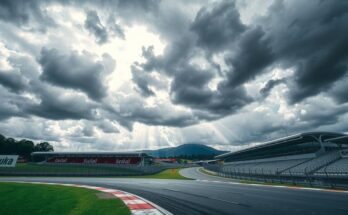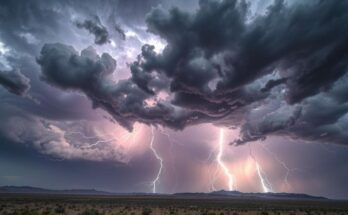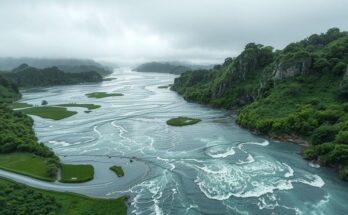On Tuesday, six tropical cyclones were active in the southern hemisphere, including Severe Tropical Cyclone Alfred, which reached category-4 strength near Australia. Cyclones Rae and Seru caused damage in the Pacific, while Cyclone Bianca moved in the Indian Ocean without landfall. Intense Tropical Cyclone Garance is expected to impact Réunion, and Severe Tropical Storm Honde is skirting Madagascar. Such simultaneous activity, though rare, is increasingly noted in tropical cyclone history.
A rare meteorological phenomenon occurred on Tuesday when six named tropical cyclones were simultaneously active in the southern hemisphere, with several situated near one another. In the south-west Pacific, Severe Tropical Cyclone Alfred emerged on February 20 in the Coral Sea, achieving category-4 hurricane strength with maximum sustained winds reaching 105 mph. Alfred is currently moving south alongside Queensland’s coast, prompting warnings for strong winds and rough seas, although it is not anticipated to make landfall.
To the east in the south-west Pacific, two short-lived storms, Cyclone Rae and Cyclone Seru, reached a maximum intensity equivalent to a category-2 hurricane. Cyclone Rae developed on February 22 just north of Fiji, moving southward across the island and causing significant damage due to heavy rainfall, strong gusts, and high waves. Conversely, Cyclone Seru formed on February 24 over the southern Solomon Islands and passed to the east of Vanuatu and New Caledonia without causing major damage.
In the south-east Indian Ocean, Severe Tropical Cyclone Bianca was active from February 18 to 27, forming in the Timor Sea to the north-west of Australia. It achieved category-3 hurricane intensity while traveling west and then south, navigating around the Australian continent without making landfall. Meanwhile, in the south-west Indian Ocean, two additional cyclones bracket Madagascar, both developed on the same day.
Intense Tropical Cyclone Garance, which formed northeast of Madagascar, is moving southward and is expected to impact the French island of Réunion with 120 mph wind gusts and anticipated rainfall of up to 600 mm. Additionally, Severe Tropical Storm Honde, classified as category 1, is progressing south-east while skirting the southern tip of Madagascar. While it is uncommon for so many named storms to develop concurrently, it is not unprecedented within the region.
Historically, the Pacific Ocean has seen six concurrent named storms only once, in August 1974. The Atlantic region holds the record for five simultaneous storms, set in September 1971. Such occurrences, although infrequent, highlight the dynamic nature of tropical cyclone activity in the southern hemisphere.
In summary, the simultaneous occurrence of six named tropical cyclones in the southern hemisphere represents a significant meteorological event, featuring a combination of varying intensities and impacts across different regions. Severe Tropical Cyclone Alfred stands out for its potential threats along the Queensland coast, while Cyclones Rae and Seru demonstrate the capacity for substantial damage. Overall, this event exemplifies the sometimes concurrent and complex nature of tropical cyclones, particularly in the Pacific and Indian Oceans.
Original Source: www.theguardian.com




